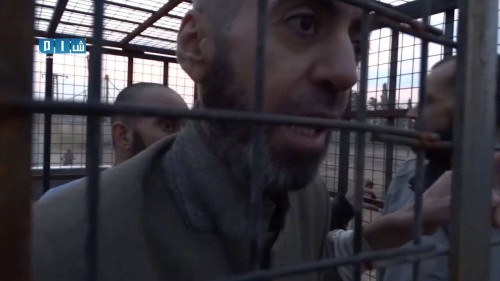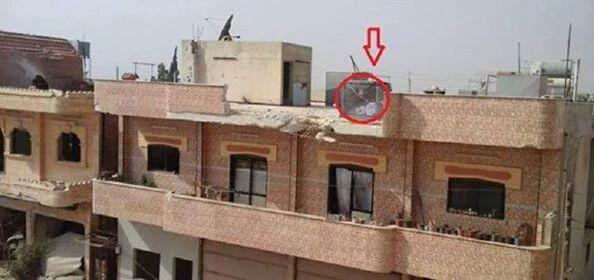PHOTO: One of the caged detainees in Douma near Damascus, shown on video on Sunday
LATEST
MONDAY FEATURES
Audio Analysis: Why Obama’s “Special Forces” Are More PR Than Substance
Video Analysis: Russia’s Challenge to Save Assad
UPDATE 1400 GMT: Civil defense teams respond to another regime attack on Douma on Monday:
An opposition correspondent said six people were killed and dozens wounded, while a doctor said he had seen “a number of dead” and more than 30 injured.
Running out of burial space, the Douma Local Council is now using six-tiered graves cut vertically into the earth, each meant to hold a single body.
“There are no longer enough white burial shrouds,” Abu Muhammad Marouf, a Douma-based human rights activist said Monday. “We have started to use colored fabric. In the August massacre [the killing of 100s in airstrikes], we had to use plastic bags.”
ORIGINAL ENTRY: Trying to deter regime attacks that have killed hundreds of people in the Damascus suburb of Douma since the summer, rebels have put prisoners of war and their families in cages in public spaces.
Jaish al-Islam, the leading rebel faction in the East Ghouta area near the capital, disseminated photographs and videos on Sunday, with the hashtag “Cages of Protection”, showing the men and women.
“The cages in Ghouta are not human shields to protect combatants, but rather have been placed among civilians to protect them,” wrote Mohammad Alloush, the director of Jaish al-Islam’s political office.
Media activist Baraa Abdulrahman said that the rebels plan to place the captives in dozens of cages on rooftops and in streets “so they can taste our misery”.
Douma has been bombarded by years by the Syrian military in an attempt to break the opposition hold, with the aerial attacks escalating in recent months. On Thursday and Friday, almost 100 people were killed and 550 were wounded when regime bombs, missiles, and shells struck civilian areas such as an open-air market.
The international medical organization Medicins Sans Frontieres said over the weekend, “This massive bombing on a crowded market and the repeated destruction of the few available medical facilities breaches everything that the rules of war stand for.”
See Video — Warning: Graphic Images
The tactic of caged human shields was first seen in Syria this summer when regime forces put prisoners atop buildings in the enclave of al-Fu’ah in Idlib Province, hoping to deter rebel shelling.
Almost all pro-opposition activists condemned Jaish al-Islam’s adoption of the shields, although soe offered explanations of anger and desperation after the latest casualties. A local media activist said bluntly, “It’s to protect the civilians,” and a resident echoed, “The cage idea has been met with criticism by some and support from others, but what alternatives do we have to protect our children from death in Ghouta?” Journalist Abdurahman Harkoush wrote:
Images of prisoners in cages in Douma are sad, but we have to focus on the real reasons behind that deed rather than evaluate it.
When you and your family live for years under siege and airstrikes, you will do many things to survive regardless of ethical considerations.
Another local media activist, Mohammad Hasan, explained:
Hopefully the Russians will stop bombing us. You can’t imagine what we witnessed during the last two days. I survived a rocket attack yesterday that landed right beside me. Two women were close to the rocket. They were torn in pieces.
Award-winning Zaina Erhaim said in a conversation on Twitter, “Try to live under constant bombing, siege, hunger, hear the screams of your kids under wreckage helplessly, then preach about acting sane!”
Jaish al-Fateh’s media activist Abdulrahman said that criticism was anticipated, “Human rights and humanitarian organizations will start calling on the opposition to release those officers,” but continued, “We didn’t hear those organizations calling to save the people of Eastern Ghouta.”
In February, the activist appealed for help from the outside world as he used children to mimic the Islamic State’s immolation of a captured Jordanian pilot. In that video, children were put in cages in orange jumpsuits while Abdulrahman asked why the world condemned ISIS’s executions but stood by as Douma’s civilians were killed in airstrikes.
However, a local paramedic doubted that the latest tactic will have any effect on the regime: “It won’t work. The air force that targets civilian neighborhoods and marketplaces won’t care if there were hostages.”
Iran: We Resisted Other Powers’ Demand For Assad Departure in 1 Year
Iran’s Deputy Foreign Minister Hossein Amir Abdollahian has said that Tehran resisted the demand of other powers, at last Friday’s Vienna conference, that Syria’s President Assad depart after one year.
Amir Abdollahian said on Sunday that the countries insisted on a “political process” beginning in six months and ending after 18.
He denounced others, including Saudi Arabian Foreign Minister Adel al-Jubeir for allegedly saying that “Syrian people are unable to determine their own political future”:
Amirabdollahian:Some Countries in #SyriaTalks believd that elections not an apt mechanism & future of #Syria needs 2B decided in the session
— Abas Aslani (@abasinfo) November 1, 2015
Both Russia and Iran, allowed into negotiations for the first time, are calling for Presidential and Parliamentary elections while escalating military support for their ally Assad.
Throughout the gathering, Mr. Al-Jubeir tried to set a timetable for President Bashar al-Assad’s departure. He wouldn’t care about the Syrian people’s right to self-determination at all, and made baseless comments.
At one point when the conference was in session and other ministers were in attendance, [Iranian Foreign Minister Mohammad Javad] Zarif responded to those remarks nonchalantly, and, at another, he openly rejected each of his comments.
Despite the recent loss of Iranian commanders and dozens of troops inside Syria, the Minister denied that Iran has put fighters onto the battlefield along the Syrian military:
#Iran DepFM Amirabdollahian: We don't have troops in #Syria, but military advisers who are in Syria because of Syrian government's request.
— Abas Aslani (@abasinfo) November 2, 2015


